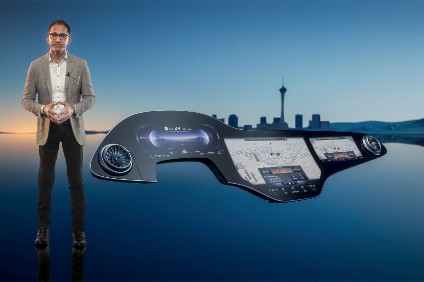 |
|
Khan presented the hyperscreen at a virtual CES |
To the great loss of airlines, hotels, convention centres, restaurants and casinos in Las Vegas (not to mention freeloading media), COVID-19 has forced the always-much-anticipated January Consumer Electronics Show (CES) to go virtual this year. Among many product launches, Aptiv has announced a new Level 1-3 capable ADAS platform and, just days after its digital world premiere, the Mercedes-Benz MBUX Hyperscreen made its trade show debut digitally.
With a width of 141 centimetres, the claimed unique screen unit consisting of three apparently seamlessly merged displays which is the largest human-machine interface Mercedes-Benz has ever made and also “by far” the most intelligent. The hype gushes from the press release: “aesthetically impressive, radically easy to operate and downright eager to learn. Thanks to artificial intelligence, the display and operating system adapt completely to the user and make personalised suggestions for numerous infotainment, comfort and vehicle functions depending on the situation.”
This isn’t vapourware, either, the hyperscreen will be launched in the electric EQS saloon.
“The hyperscreen combines unique electrical aesthetics with outstanding user-friendliness. A decisive strength is the clever networking of all systems based on intelligent, adaptive software. This makes the hyperscreen the brain of the car; it’s connected to and communicates with all components of the vehicle,” said Mercedes-Benz CTO Sajjad Khan.
Daimler kept an additional feature for the CES digital debut: Mercedes Travel Knowledge, an intelligent function which evaluates map data andvehicle surroundings and provides information about landmarks along the route, from individual buildings, points of interest to entire cities. A vehicle occupant can simply ask a question as they drive past – for example, “Hey Mercedes, what can you tell me about this building?” or “Hey Mercedes, what is the name of the restaurant on the left?” – and the information appears on the respective display and is spoken by the voice assistant. MBUX updates via the cloud will also add this feature to the recently launched redesigned S-Class.
To get to the most important applications on the hyperscreen, the user does not have to scroll through submenus or enter voice commands – Mercedes-Benz calls the system a zero layer. The most important applications, such as navigation or telephone, are always offered situationally and contextually on the top level in the field of vision. Twenty other functions – from the active massage programme to suggestions for the to-do list – are automatically displayed with the help of artificial intelligence if they are relevant for the occupants.
“The focus was clearly on the customer,” said Khan. “The goal was a concept without distracting the driver or complicated operation but one that is capable of learning thanks to artificial intelligence. The result speaks for itself: the hyperscreen understands the customer better and better and thus delivers a customised, personalised infotainment and operating offer before the user has to click on anything. This is customer orientation and digital thinking in 2021.”
For haptic feedback during operation, 12 actuators are located under the touchscreen surfaces. If a finger touches certain areas there, they trigger a noticeable vibration of the cover plate. Eight CPU cores, 24 gigabytes of RAM and 46.4 gigabytes per second RAM memory bandwidth are among the technical highlights.

